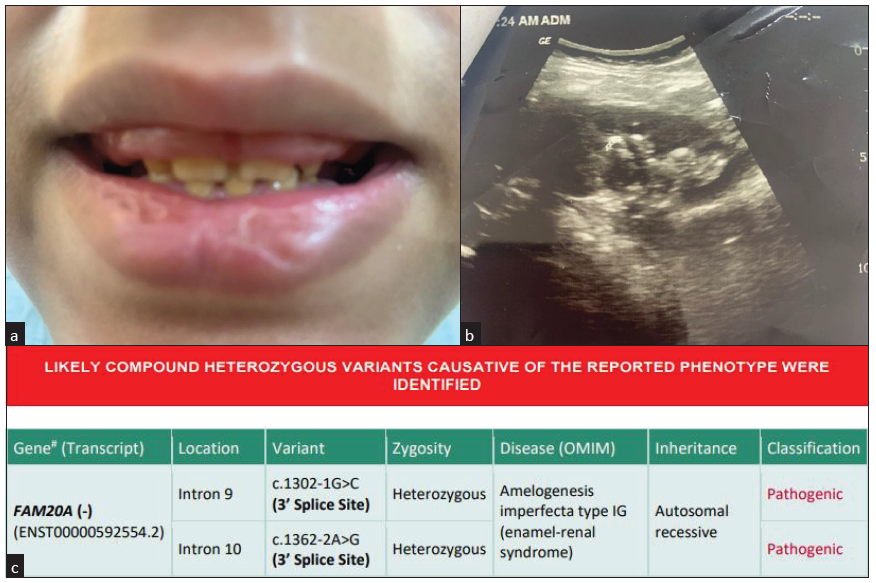Translate this page into:
Enamel Renal Gingival Syndrome: A Rare Form of Dystrophic Gingival Calcification with Nephrocalcinosis
Corresponding author: Suprita Kalra, Department of Pediatrics, Command Hospital, Pune, Maharashtra, India. E-mail: kalrasuprita@gmail.com
-
Received: ,
Accepted: ,
How to cite this article: Maj Priyamol TM, Shruti M, Badal S, Kalra S. Enamel Renal Gingival Syndrome: A Rare Form of Dystrophic Gingival Calcification with Nephrocalcinosis. Indian J Nephrol. 2024;34:199–200. doi: 10.25259/ijn_162_23.
Enamel renal syndrome (ERS; OMIM 204690) is a rare autosomal recessive disorder characterized by hypoplastic amelogenesis imperfecta, failed tooth eruption, intrapulpal calcifications, gingival enlargement, and nephrocalcinosis.1,2
A 12-year-old boy presented with poor enamel formation, noticed by his parents, since early infancy. He was otherwise asymptomatic and developmentally normal for his age, with weight and height being between the 75th and 90th centile for his age. He was normotensive and had normal head-to-toe and systemic examination, except small widely spaced teeth with a yellowish brown discoloration with absent enamel layer [Figure 1a]. His investigations were all within normal limits, except nephrocalcinosis and multiple small calculi in both the kidneys on ultrasonography of the kidneys [Figure 1b]. Histopathology of gingival tissue from the upper premaxillary region showed dystrophic gingival calcifications. Genetic workup proved compound heterozygous pathogenic mutation in FAM20A gene and the patient was diagnosed with amelogenesis imperfecta type 1G (enamel renal syndrome or ERS). This mutation was also confirmed on Sanger sequencing [Figure 1c].

- Yellowish brown discoloration of teeth with absent enamel layer and gingival thickening. (a) Amelogenesis imperfecta with thin enamel, (b) bilateral nephrocalcinosis seen on Ultrasound of the kidneys, (c) compound heterzygous pathogenic variant detected in the child on Whole exome sequencing with bold values highlighting the pathogenic variant. OMIM: Online Mendelian Inheritance in Man.
ERS is a rare autosomal recessive disorder that is characterized by amelogenesis imperfecta of the hypoplastic type and nephrocalcinosis (OMIM #204690). It presents with presence of a thin enamel or absence of it, delayed dental eruption, intrapulpal calcifications, bilateral nephrocalcinosis with normal plasma calcium level, and normal renal function tests due to an underlying mutation in the FAM20A gene. Only a few cases have been reported worldwide with the complete spectrum of hypoplastic enamel and nephrocalcinosis as described first by MacGibbon.3 ERS should be suspected in children with absent/abnormal enamel.
Acknowledgement
Surg. Capt. Dr. Chengappa, Orthodontist, INHS ASVINI.
Ethical approval
Institutional Review Board approval is not required.
Declaration of patient consent
The authors certify that they have obtained all appropriate patient consent.
Financial support and sponsorship
Nil.
Conflicts of interest
There are no conflicts of interest.
Use of artificial intelligence (AI)-assisted technology for manuscript preparation
The authors confirm that there was no use of artificial intelligence (AI)-assisted technology for assisting in the writing or editing of the manuscript and no images were manipulated using AI.
References
- Nephrocalcinosis (enamel renal syndrome) caused by autosomal recessive FAM20A mutations. Nephron Physiol. 2012;122:1-6.
- [CrossRef] [PubMed] [PubMed Central] [Google Scholar]
- Enamel renal syndrome: A systematic review. Indian J Nephrol. 2021;31:1-8. doi: 10.25259/ijn.IJN_27_19
- [CrossRef] [PubMed] [PubMed Central] [Google Scholar]
- Generalized enamel hypoplasia and renal dysfunction. Aust Dent J. 1972;17:61-3.
- [CrossRef] [PubMed] [Google Scholar]






